We’ve just returned home from our first car camping weekend of the summer. Our home was our Kelty tent perched high above the Ohanapecosh River, swollen with snowmelt off the southeastern flank of Mount Rainier. My ears are still delightfully roaring from the sound of the river, and I may have cedar twigs dangling from my hair as I type this.
I could not have gotten our family out the door on Friday without my trusty car camping checklist, honed to near-perfection after years of trial and error.
Much of the backcountry experience under my boots is from backpacking, which necessitates decisiveness when it comes to packing. After all, each additional item that goes in means a heavier backpack, schlepped over miles of hiking trail. Not so with car camping. Theoretically, you could pack every comfort from home and bring it along with you. Some campgrounds have electricity in the bathrooms. Imagine, you could even pack your hair dryer!
I promise you, there is no hair dryer on my car camping pack list. The key to a great car camping checklist (and car camping experience) is to trim down to the basics with just a handful of comforts tossed in. This will help you find a near-perfect balance of enjoying the great outdoors while still being quite comfortable.
Below, I share with you my car camping checklist. I use a checklist, always, so that I won’t ever find myself in the middle of the Wenatchee National Forest without tent poles again. Keep this checklist with your camping gear so it’s always handy when you need it.
Click for a print-friendly PDF of the car camping checklist.
Shelter
Need a tent? We put together this handy tent finding guide that will help you zero in on some good options for your needs (what size tent is best for you, how much rain protection you need, the best tent on a budget, etc.) Most tents come with a rain fly and ground cloth (also called footprint) but some don’t – so check. A regular old blue tarp will work as a ground cloth (or rain fly) in a pinch. (In fact, for car camping I rather prefer a sturdy tarp as a groundcloth). Always try out a new tent in your backyard or city park before heading out into the wilderness so that you are familiar with how to assemble it and know you have all the parts you need. I sometimes skip the extra tarp and rope on this list, but if it’s raining, it’s so nice to have a tarp hung over your head while you’re cooking up dinner.
- Tent
- Tent poles
- Rain fly
- Ground cloth or tarp
- Extra tarp and rope
- Camp chairs to sit on around camp
Sleeping
- Sleeping pads, cots or air mattress
- Sleeping bags (optional: extra blankets)
- Pillows (or pillow cases to stuff clothes in and create a pillow)
Cooking Meals
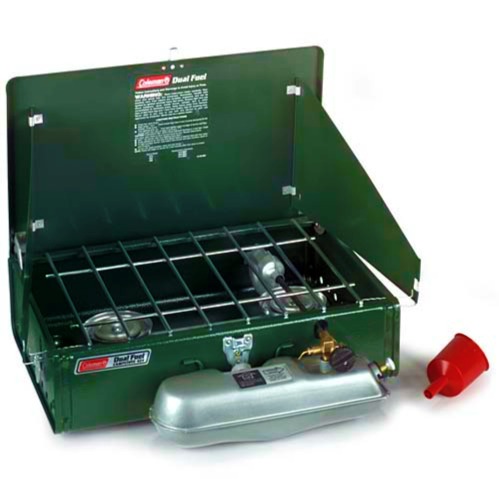 We have two stoves – a basic Coleman propane stove for car camping, and an MSR Pocket Rocket backpacking stove (which is one of my favorite things, like in the world.) In my experience, dual-fuel stoves can be a little tricky, and so we always bring the MSR along on car camps just in case. I’ve no doubt that our issues with the Coleman have been user-error. It illustrates, though, that you should know how to use your stove really well before you get to camp. Learn how to use it before you leave the store. If you buy your stove online, practice assembling and lighting the stove in your driveway before you go. In fact, you will ideally test your stove each and every time before you go camping. For cookware, I use Seattle-based MSR products and think they’re the best – this stainless cookset is all you need.
We have two stoves – a basic Coleman propane stove for car camping, and an MSR Pocket Rocket backpacking stove (which is one of my favorite things, like in the world.) In my experience, dual-fuel stoves can be a little tricky, and so we always bring the MSR along on car camps just in case. I’ve no doubt that our issues with the Coleman have been user-error. It illustrates, though, that you should know how to use your stove really well before you get to camp. Learn how to use it before you leave the store. If you buy your stove online, practice assembling and lighting the stove in your driveway before you go. In fact, you will ideally test your stove each and every time before you go camping. For cookware, I use Seattle-based MSR products and think they’re the best – this stainless cookset is all you need.
If you prefer to cook over a campfire (we sometimes do) I recommend investing in this Lodge 5-Piece Pre-Seasoned Cast-Iron Cookware Set (it includes a dutch oven, and often goes on sale for 50% off). Most campgrounds have a grate over the fire pit that you just set the cast iron pots on for cooking, or you can buy your own grate for primitive campsites. If you like cooking a big pot of something in a dutch oven, you’ll probably want a campfire tripod to hang it from (most campgrounds do not have a tripod over the fire pit, so bring your own).
- Camp stove
- Fuel (white gas, propane – different stoves require different fuels)
- Firestarter (matches and lighter)
- Cookset (pots/pans) and cooking utensils
- Coffee maker / percolator
- Eating utensils (plates, bowls, cups, forks, spoons for each person)
- Garbage bags
- Ziplock bags in various sizes
- Aluminum foil and/or saran wrap
- Biodegradable soap and a sponge
- Bucket or camp sink for washing dishes
- Handkerchiefs (we use these as napkins) and dish towels
- Paper towel roll
- Can opener, bottle opener, knife, cutting board, etc.
- Cooler and ice
- Tablecloth for picnic table
- Jugs of drinking water (if not available)
- Empty pitcher or jug for transporting water (if the campground provides potable water)
Food
Car camping gear is usually a bit easier to prescribe in a list than car camping food. I have some basic items below, but the key here is to plan out each and every meal in advance and have the complete list of ingredients you will need for the dishes you plan to make. I pre-measure and pack all of my ingredients beforehand, keeping all of the ingredients together that I’ll need for each meal in separate gallon-sized ziplocks. Repack bulky items like boxed pasta to leave excess packaging at home. This makes cooking a cinch and helps cut down on camp clutter and trash. Don’t forget any utensils you will need, such as a can opener, cutting board or bottle opener. (Many multitools have several useful utensils built into one device. I use this medium-priced Swiss Army Knife).
One of my favorite sources of camp recipes is the Seattle area-based trailcooking.com. Take their recipes with you using their book, Trail Food Made Gourmet.
- Ingredients for each meal (and recipes, if needed)
- Snacks for energy and high on variety, like bars, trail mix, raisins, jerky, mixed nuts, cheese crackers, m&ms, yogurt pretzels and sesame sticks. Parmesan and cheddar cheese keeps well.
- Dried fruit and sturdy fresh fruit like apples
- Bread and the makings for PB&J (great to have on hand for extra food if your stove doesn’t work!)
- Salt, pepper, and other condiments (like cooking oil).
- Coffee and cream/sugar or tea
- Hot cocoa mix (and insulated mugs!)
- Other beverages (milk, pop, juice, koolaid mix)
- Popcorn and campfire popper
- Makings for s’mores (graham crackers, marshmallows and chocolate. We add cinnamon or peanut butter, too)
Camping Safety
 A lot of this stuff is in our car earthquake survival kit already, and may be in yours, too. It’s easy to create your own first aid kit from items you already have at home, but here’s an affordable first aid kit that is great to grab and go for a day hike or a car camping trip.
A lot of this stuff is in our car earthquake survival kit already, and may be in yours, too. It’s easy to create your own first aid kit from items you already have at home, but here’s an affordable first aid kit that is great to grab and go for a day hike or a car camping trip.
Many campgrounds provide safe drinking water (often called potable water in the campground’s amenity details), but some primitive ones do not. Pack in your own water in a vessel (like this one from Coleman) or bring a water filter, provided there’s a natural water source nearby. I’ve relied on this Katadyn water filter for twelve years of healthy drinking out of streams and lakes in the Cascades and Olympics and it has never let me down. In the event that you show up to a campground without potable water and you didn’t bring a filter, all is not lost. In a pinch, you can always boil stream water to ensure it is safe to drink. Just gather water from a stream and boil it for one minute plus an additional minute for each 1,000 feet of elevation you are at (so if the campground is at 4,000 feet elevation, boil the water for 5 minutes). This method consumes a lot of stove fuel and time, so I don’t recommend it unless you’re in a pinch.
Call me over prepared, but yes we do pack two-way radios for car camping trips. We might be alone in this oddity, but cell phones aren’t reliable in the woods and these are. If my husband takes a walk with our kid while I’m cooking dinner, I can radio him when it’s ready. See? I’m going to start a trend here – just wait.
There are a few other products I have found to be indispensable in the backcountry. One is this product called Sting Eze. I get bitten like crazy by mosquitoes, even when the person I’m hiking with is blissfully left alone. If I apply this stuff right after a bite, it is far less bothersome to me. To prevent getting eaten alive, I admit to using deet. I use this Jungle Juice stuff. It works fairly well in all but the buggiest of alpine lakes in late July.
- First-aid kit with different bandages, ointments, etc.
- Insect repellent (non-toxic for kids) and Sting Eze
- Citronella candle to keep bugs away from the picnic table
- Sunblock for sensitive skin
- Duct tape (good for all kinds of quick repairs)
- Moleskin (for those pesky blisters)
- 100% aloe vera gel for accidental sunburn
- Calamine lotion for poison oak
- Hydrocortisone for skin reactions
- Water filter or purification tablets (just in case)
-
Headlamps (one for each person)
- Flashlight and extra batteries
- Whistle (for calling out for help)
- Walkie Talkies (two-way radios)
- OTC medications like advil and aspirin
- Prescription medications for your family members
- Allergy medication like benedryl
- Directions to the nearest emergency medical facility
- Cell phone, and a car charger for it
Toiletries and Personal Items
I use wet wipes for cleaning up all kinds of little messes when car camping. Whenever possible, get your toiletries unscented. I remember spending a paranoid night in a tent in Alaska grizzly country because my deodorant smelled like lavender.
- Washcloths and towels (for swimming or bathing)
- Biodegradable soap / shampoo
- Toothbrushes/paste
- Toilet paper (and a trowel if there is no flush or pit toilet)
- Wet wipes (handy for cleaning hands and face)
- Hand sanitizer
- Deodorant
Clothing
Wear whatever is comfortable when you’re camping. I live in leggings at camp. Bring layers like a lightweight fleece or down vest to stay warm at camp when the temperature dips at night. My “camp shoes” of choice are Chaco sandals, which double as hiking sandals. Again, I like to keep things simple. However, I don’t skimp on quality, because I hike a lot and wear things hard. Day hiking is almost always on the agenda, so pack accordingly.
- Rain gear
- Fleece jacket and/or down vest
- Hiking shoes or boots
- Camp shoes (sandals or crocs)
- Socks (avoid cotton, instead try wool socks or polypro)
- Long underwear top/bottom (wool or polypro)
- Shorts (Patagonia baggies are the best, ever.)
- Pants
- Shirts (think layers – tank, tshirt, long-sleeved tshirt)
- Underwear
- PJ’s
- Swimming suits
- Warm hat and gloves
- Sunglasses and baseball hat
Miscellaneous
- Small broom (good for sweeping off the picnic table or sweeping out the tent)
- Your campground reservation info
- DeLorme Gazetteer for the state we’re camping in
-
Directions to the campground
- Cash and quarters (some campgrounds have coin-operated showers)
- Hiking guidebook for nearby trails
- Binoculars and nature guidebook
- Emergency contact numbers for our car and on our person
- Digital camera
- Water bottles for each person
- Daypacks for day hiking
- The Ten Essentials for the daypack
- Books and games
If you’re packing for a family, your car camping checklist will naturally be a little longer. Babies require everything from diapers to a pack ‘n play (we’re past that stage.) For older kids, remember to bring along some activities like a frisbee, bikes, scooters and fishing poles to keep the kids occupied and happy (and to help keep their minds off the iPad you left back at home.)
Happy camping!
P.S. Don’t forget to download the Car Camping Checklist as a PDF here so it’ll be a cinch to pack for your next camping trip!



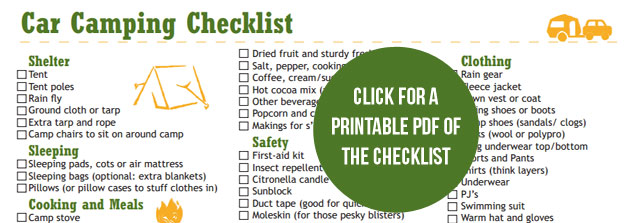
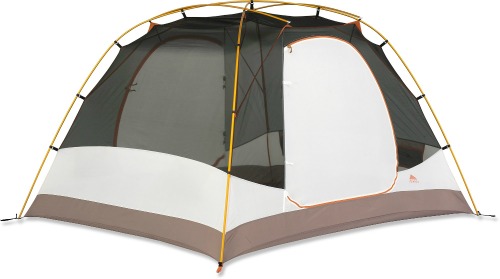
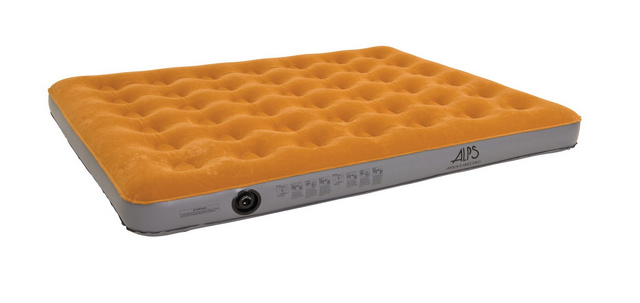

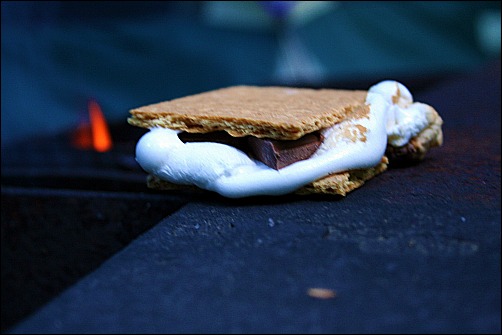

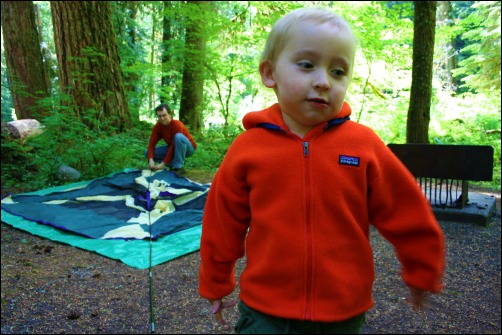
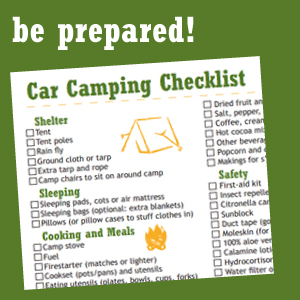
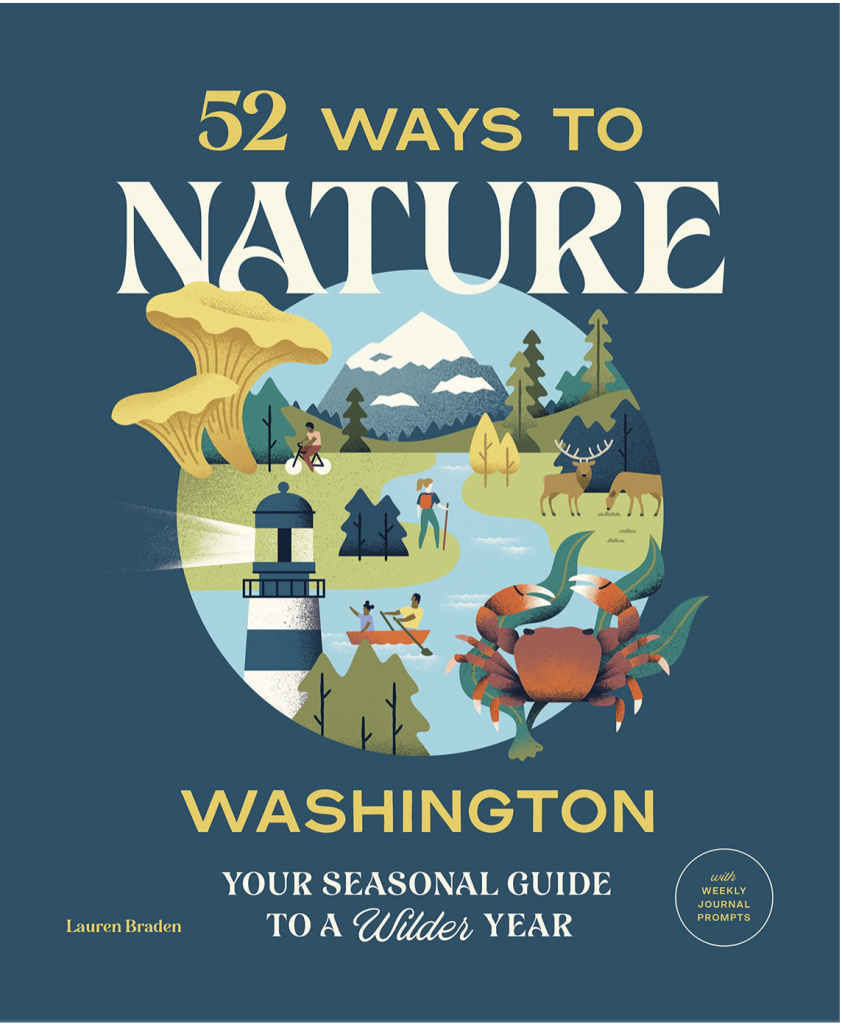


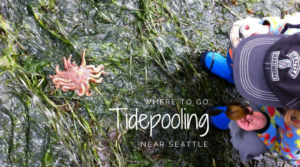



10 Responses
Good stuff.. I am planning on heading out pretty soon with the fam myself…
One query though.. Is this where you bought all your stuff? I like you suggestions and would hook it up by buying from your links, but everythign is WAY more expensive then I find elsewhere.
Anyway.. thanks for the article.. will def read it again a week before I head out.
Hi Radie, thanks for the comment.
If I buy gear from a store, I often do buy it at REI. I’m an REI co-op member (a one-time $20 fee) and so a portion of all of my purchases (10%) comes back to me every February as a member “dividend,” like a refund. I sometimes cash it out, but if you spend your dividend in the first 30 days after you get it, you can get 20% off one full-priced item at REI. Many people wait for this opportunity each year to make their big gear purchases at REI – a tent, bike, kayak, backpack, etc.
REI’s prices are usually consistent with other places for the exact same items, so I am thinking it’s my choice of items that seems so expensive to you. I have terribly expensive tastes when it comes to outdoor gear, even being the budget traveler that I am. Your outdoor gear is an investment and if you make good purchases, take care of your gear by cleaning it every time you use it and repairing a tear as soon as it happens, some of this stuff could last decades. Everything I linked to is the model I own or one that I have gear-tested. I know there are a few items that are really expensive. You could find a much cheaper tent if you went with Coleman, for example, Our Kelty is a mid-priced 4-person tent, but it is light enough to take backpacking, which is important to me in a family tent because we hope to start backpacking with our kid next summer.
Also, I work for a hiking organization, so I’m surrounded by gearheads all day. We talk about gear a lot. Some people go to work and talk about their cars, we go to work and ooooh and aaaaah over the weight of each other’s tent poles. And we get some good “prodeals” sometimes from the brands themselves (not from REI, inc.).
One idea for folks looking to save money – try buying used gear. If people live near Seattle, Secong Ascent in Ballard is terrific – I’ve bought used skis there, a gortex rain jacket, and more. (Anyone know of a good used gear store in Portland?) Also, if you aren’t ready to commit to being a car camper but want to try it without buying all the gear, I have two ideas. (1) you can rent gear at REI or other places just for a weekend, or (2) go with another family or group of people that has this stuff. You can easily share one stove among a few adjoining campsites.
Radie – have a great camping trip!
We like you, started out with backpacking, but as the kids and years came along integrated car camping into our activities list. We found one new invention that has been pure love, rain or shine. That is the 10×10 quickshade. My goodness that thing is wonderful! When east of the mountains in the hot sun it is just great to have the relief, and west of the mountains when we find ourselves camping in cool or wet conditions, it is also great for respite from the rain and pine needles. We always put it over half of the picnic table and our lightweight camp table. That let’s us cook, sit and eat, and spend time out of the rain, or in the shade. You gotta get one!
Andrew, I’m liking this Quick Shade idea. I can imagine many uses, even over the sandbox in the yard. Thanks!
We love our air mattresses and we like them FIRM. They used to take forever to fill up with the cheapo foot pump and then they needed to be topped off every couple of nights because they inevitably leak just a teeny bit. This summer I indulged in a cordless electric pump and it ROCKS. It fills them in a jiffy and stays charged forever. I literally have only charged it once this summer, and we’ve been in a tent in the back yard for almost a month now (just for fun), with me topping the mattresses off every couple of days. Plus, a benefit I was not anticipating, the model I bought also deflates, so you can suck all the air out of the air mattress and fold it up as small as the day it came out of the box. A car camping miracle!
Thanks for the article, I enjoyed your style of writing and comments. Your checklist will come in handy for the next camping trip.
Hope you are enjoying your summer!
Cheers,
Jason
just wanted to pass along BIG THANKS for this info – much appreciated!
You’re welcome – glad you find it useful!
I, too, have a master camping list and could not get along without it! I also really like REI gear. A month ago we got 2 inches of rain and pea size hail in our REI Kingdom tent in the BWCA. I was high and dry on our double tall air mattress and the tent was unscathed!
Nice article! We’re getting back into camping now that our child is older and excited about it, its good to have a refresher like this.